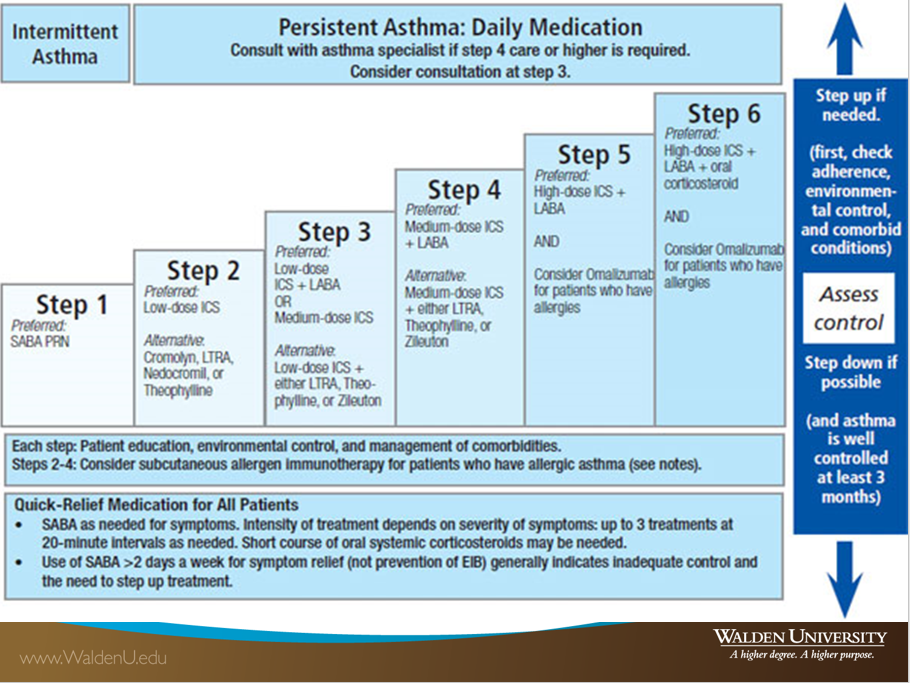Walden NURS 6521 Asthma and Stepwise Management
Asthma and Stepwise Management
Student’s Name:
Institutional Affiliation:
Objectives
- Brief discussion of Asthma and its symptoms.
- Description of options for treatment for quick-relief long-term control.
- Explanation of stepwise approach in treating and managing asthma.
- Explanation of benefits of the stepwise strategy for care providers and asthma patients.
Asthma
- Chronic illness severely impacting the airways.
- Results in airways swelling, narrowing and producing excessive mucus.
- As a consequence, breathing becomes difficult and wheezing and coughing is triggered.
- Condition varies from person to person.
- Can be minor nuisance or a severe effect interfering with daily activities.
- It cannot be cured but symptoms can be managed.
Long Term Controls
- Therapy’s goal involves controlling asthma through;
– Impairment reduction
– Reducing Risk
- Involves taking vital medications to keep asthma under control.
- Preventive medications used in treating airway inflammation that causes symptoms like coughing or breathlessness.
- Medications are used daily to eliminate or reduce asthma flair-ups.
- Examples include:
– Corticosteroids
– Immunomodulators,
– Methylxanthines, and
– Long acting beta agonists (Can et al., 2020).
Quick Relief
- Also referred to as rescue medications or inhalers.
- Utilized as needed for quick opening of airways to make breathing easier.
- The medications can aid in preventing impeding asthma attacks.
- Involves fast-acting medications like:
– Anticholinergics
– Short acting beta agonists.
Stepwise Approach
- Involves appropriate monitoring of medication utilized in controlling and managing asthma.
- Involves increasing or decreasing medications as necessary to achieve or maintain control.
- Applicable to all patients with asthma.
- It decreases morbidity and improves self-management.
- Includes six steps used in ensuring the best results are attained.

Benefits to Care Providers and Patients
- Patient empowerment and education
- Providers can control the environment around the asthma condition to manage it effectively.
- Reduction of exacerbations.
- Control of comorbidities and reduction of impairments.
- Guidance to providers on how to balance medications for the patient.
Conclusion
- Asthma is a chronic illness severely impacting the airways.
- Long-term control medications are the key to keeping your asthma controlled and in the green zone.
- Quick relief medications give fast relief for asthma symptoms and can prevent impeding asthma attacks
- Asthma management recommendations integrate various therapy components into a stepwise therapeutic approach where medications are adjusted for achievement and maintenance of control.
- The stepwise approach is beneficial to both care providers and patients in attaining control and management of asthma.
References
Blake, K., & Raissy, H. (2018). Asthma Guidelines from the National Asthma Education and Prevention Program: Where Are We Now?. Pediatric Allergy, Immunology, and Pulmonology, 31(1), 37-39.
Can, C., Akkelle, E., Özdemir, P. G., Yazıcıoğlu, M., & Süt, N. (2020). Assessment of regular drug use and inhaler technique skills in asthmatic children. Allergologia et Immunopathologia, 48(2), 124-129.
Our Advantages
Quality Work
Unlimited Revisions
Affordable Pricing
24/7 Support
Fast Delivery